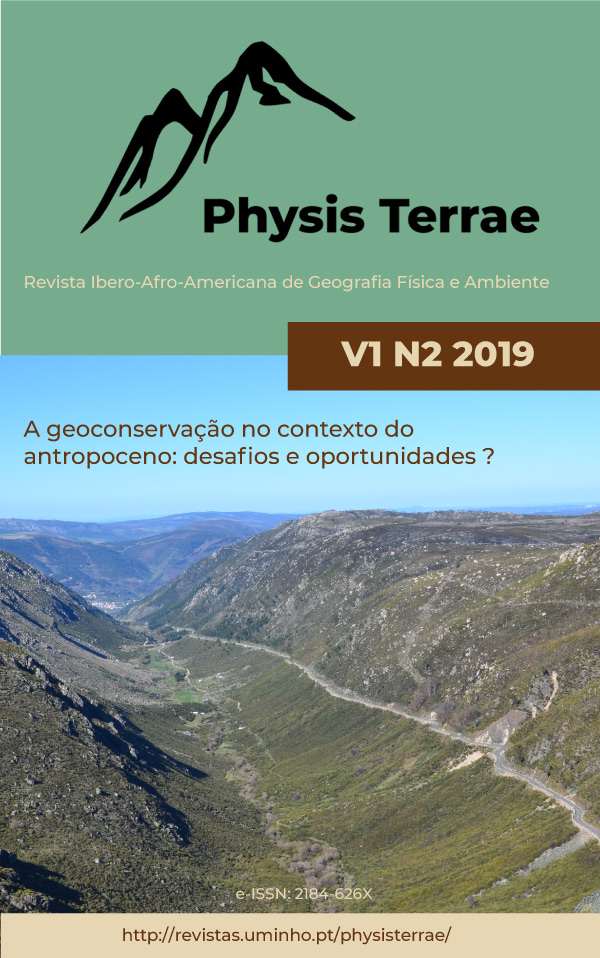The production of geoeductive materials in the proposal of the Fourth Colony Geopark, RS
DOI:
https://doi.org/10.21814/physisterrae.2274Keywords:
Geoeducation, Fourth Colony Geopark, Pedagogical instruments, Geoconservation.Abstract
In the central region of Rio Grande do Sul (Brazil), nine municipalities with great relevance in geological-geomorphological, paleontological and historical-cultural heritage represent the territory of one of the project of geopark currently under construction in the state. The heritage richness of this territory is expressed in very rare Triassic fossils, features and geomorphological processes typical of transitional environments between rugged plateaus and extensive areas of alluvial deposition, great biodiversity and preserved cultural heritage evidence dating back to italian and german immigration in this territory in the second half of the 19th century. Several studies point to the importance of pedagogical strategies that can act in this context, Thus, geo-educational materials serve as tools for the dissemination of scientific knowledge. However, the construction of these instruments requires an approach that contemplates the context of the subjects involved and the territory in question. Some educational materials are already being developed, such as a Role Playing Game (RPG), a fourth colony geopark textbook and a large-scale model of the territory, translating the geopatrimonial richness of the territory into a school language. The elaboration of these materials results in strategic tools of awareness and appreciation of heritage and in the awakening of the interest of the use of geosites as a geotouristic attraction.
Downloads
References
Azman, N., Halim, S. A., Liu, O. P., Komoo, I. (2011). The Langkawi Global Geopark: local community's perspectives on public education. International Journal of Heritage Studies, 17 (3), 261-279. https://doi.org/10.1080/13527258.2011.557863
Brilha, J. B. R. (2009). A Importância dos Geoparques no Ensino e Divulgação das Geociências. Revista do Instituto de Geociências – USP, 5, 27-33. http://dx.doi.org/10.11606/issn.2316-9087.v5i0p27-33
Borba, A. W. (2011). Geodiversidade e geopatrimônio como bases para estratégias de geoconservação: conceitos, abordagens, métodos de avaliação e aplicabilidade no contexto do Estado do Rio Grande do Sul. Pesquisas em Geociências, 38(1), 3-13. https://doi.org/10.22456/1807-9806.23832
Edelson, D.C. (2012). Geo-literacy. Disponível em 23/10/2019, em: http://education.nationalgeographic.com/education/geoliteracy/?ar_a=1&force_AR=True
Farsani, N. T., Coelho, C. O. A., Costa, C. M. M., Amrikazemi, A. (2014). Geo-knowledge Management and Geoconservation via Geoparks and Geotourism. Geoheritage, 6(3), 185–192. https://doi.org/10.1007/s12371-014-0099-7
Godoy, M. M., Binotto, R. B., Silva, R. C. da, Zerfass, H. (2012). Geoparques/propostas: Quarta Colônia (RS). In: Schobbenhaus, C., Silva, C. R. da (Org.). Geoparques do Brasil: propostas. (pp. 417-456). Rio de Janeiro: CPRM.
Langer, M. C., Ribeiro, A. M., Schultz, C. L., Ferigolo, J. (2007). The continental tetrapod-bearing Triassic of south Brazil. New Mexico Museum of Natural History and Science Bulletin, 41, 201-218.
Martínez-frías, J., Mateo Mederos, M. E., Lunar, R. (2016). Los geoparques como áreas de investigación, geoeducación y geoética en geociências planetarias: el geoparque de Lanzarote y Archipiélago Chinijo. In: IX Congreso Geológico de España, Huelva.
Motta, V. (2019). O uso do RPG como instrumento didático no projeto do Geoparque Quarta Colônia/RS. Dissertação de Graduação em Geografia Licenciatura, Universidade Federal de Santa Maria, Santa Maria/RS.
NGS – NATIONAL GEOGRAPHIC SOCIETY. (sd) Geo-education: essential preparation for an interconnected world. Disponível em 23/10/2019, em: https://www.nationalgeographic.org/education/geo-education-essential-preparation-interconnected-world/
Pereira, R. G. F. de A. (2010). Geoconservação e desenvolvimento sustentável na Chapada Diamantina (Bahia – Brasil). Tese Doutoramento em Ciências. Braga: Univ. Minho.
Pitano, S. C., Roqué, B. B. (2015). O uso de maquetes no processo de ensino-aprendizagem segundo licenciandos em Geografia. Educação Unisinos, 19(2), 273-282. https://doi.org/10.4013/edu.2015.192.11
Schmit, W. (2008). RPG e educação: Alguns apontamentos teóricos. Dissertação de Mestrado em Educação, Universidade Estadual de Londrina.
Sechin, D. N. (2019). Estratégias interpretativas integradas para o patrimônio cultural, natural e paleontológico da Quarta Colônia-RS. Texto inédito.
Soares, D. B., Santos, V. M. N. (2017). Educação, Ambiente e Aprendizagem Social na Formação de Professores para Geoconservação. Terræ, 14(1-2), 41-53. http://dx.doi.org/10.24109/2176-6681.rbep.98i249.2758
Takayuki, A. (2016). Overview: The Educational Capabilities of Geoparks: From Education to Learning. Journal of Geography, 125(6), 775-778. https://doi.org/10.5026/jgeography.125.775
Van Loon, A. J. (2008). Geological education of the future. Earth-Science Reviews, 86(1-4), 247-254. https://doi.org/10.1016/j.earscirev.2007.08.005
Zerfass, H. (2007). Geologia da Folha de Agudo, SH.22-V-C-V, escala 1:100.000. Serviço Geológico do Brasil-CPRM, CD-ROM.
Ziemann, D. R. (2015). Levantamento preliminar do potencial geoturístico no território do projeto geoparque Quarta Colônia, RS. In: XI Encontro Nacional da ANPEGE. Disponível em 23/10/2019, em: https://www.researchgate.net/publication/282976362_levantamento_preliminar_do_potencial_geoturistico_no_territorio_do_projeto_geoparque_quarta_colonia_rs
Ziemann, D. R., Figueiró, A. S. (2017). Avaliação do Potencial Geoturístico no Território da Proposta Geoparque Quarta Colônia. Revista do Departamento de Geografia, 34, 137-149. https://doi.org/10.11606/rdg.v34i0.135156


